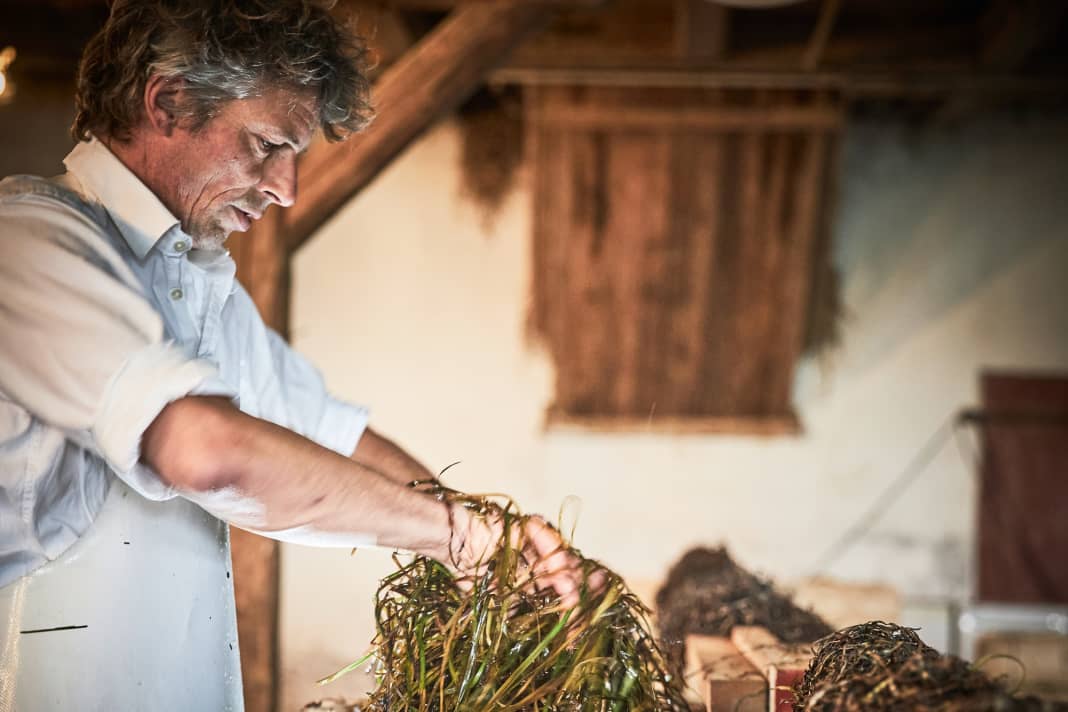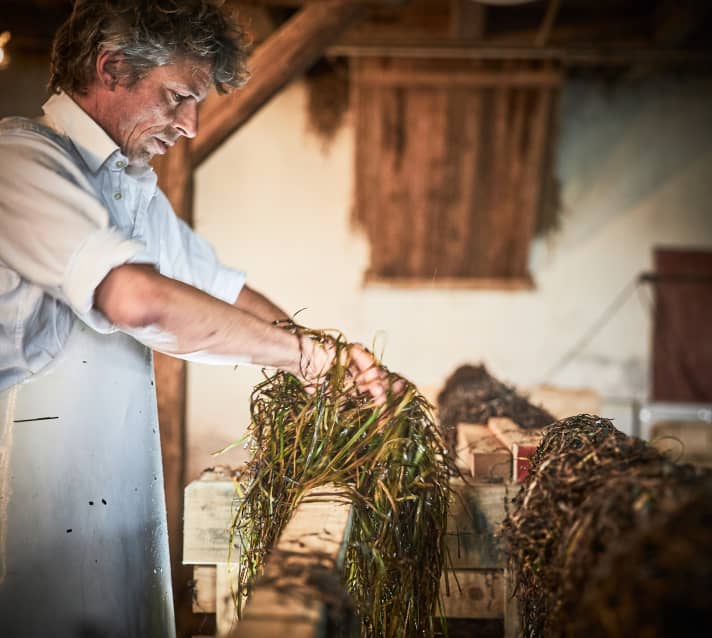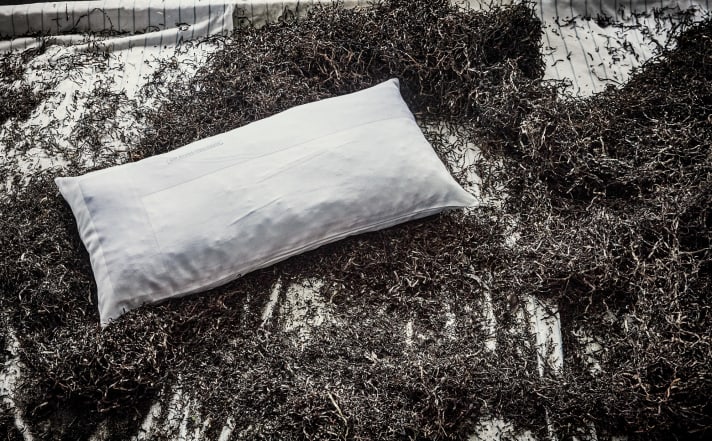





The waves of the Baltic Sea have white crests of foam, the autumn wind from the east whistles along the cliffs, sweeps over the beaches and the surf has been thundering against the coast for days.
That's good news for Kristian Dittmann from Kappeln an der Schlei, because it means harvest time. Wearing green wellies, he climbs into his old Mercedes flatbed lorry. Wheelbarrow, big-pack sacks and a fork are lashed to the loading area. He drives to the Baltic Sea beach in nearby Eckernförde. It is so early in the morning that not even the walking dogs have marked their sandy territory yet.
Dittmann parks the lorry on the beach, breathes in the fresh sea air and gets to work: at the edge of the tide, he pushes the fork into the coveted raw material and heaves it onto the wheelbarrow: seaweed, shimmering green in various shades and dripping wet. The sea is supplying a lot today, the grass lies on the beach like a thick pelt. The collector lets the fork perform little pirouettes, turns it back and forth in circular movements and sifts out the unwanted "by-catch" - bladder wrack, bird feathers or plastic waste.
Seaweed is materialised sea
"Seaweed is a high-quality raw material, materialised sea," explains Dittmann. He grabs a handful of the shiny, damp grass and smells it. "The scent of salt, wind and sea," states the expert. This disproves the widespread prejudice of "flotsam", the washed-up flotsam of seaweed, algae, wood and rubbish that smells of fish and decay. Only protein-rich algae such as bladder wrack and animal carcasses cause the decomposition process to produce extreme odours and drive holidaymakers from inland to flee.
Dittmann has been running the Strand-Manufaktur on the Schlei for seven years and specialises in the manual production of cushions made from seagrass. The 51-year-old doesn't look his age, he has retained the inquisitive look of youth and is agile in his physical work in the fresh air. Before he became a family man eight years ago, he sailed hundreds of miles on the Baltic Sea and as far as the Canary Islands in his plywood catamaran. The sea has always been home to him, now the seaweed provides his connection to the sea.
Seagrass is important for animals and the climate
Dittmann's view of the seagrass extends far, far beyond the tide line in easterly winds. He is an ambassador for Zostera marina, the common seagrass from the Zosteraceae family - plants that grow submerged on sandbanks around seven metres deep on seashores all over the world, where they form seagrass meadows and are important habitats for fish and other aquatic animals. The climate also benefits from the growth in the water: large quantities of carbon dioxide are bound and, like rainforests, reduce the greenhouse effect.
The annual plants regularly detach from the seabed in large quantities in autumn and drift to the coast with the wind. There, anyone can collect and utilise them without interfering with the seagrass meadows. Like many other coastal ecosystems, these plants are under severe threat from over-fertilisation, warming of the seawater, displacement by invasive species and human activities.

Seagrass is a versatile raw material
"Seagrass is incredibly versatile and has great potential, especially in today's world, where healthy products, sustainability and climate protection are important," explains the pioneer and visionary from Kappeln. And he would like to communicate this to the coastal inhabitants; "Fridays for Future" starts on the beach and with seagrass.
And indeed, more and more people are recognising the potential of the marine plant: a seagrass trader imports the raw material from the Danish Baltic Sea island of Møn to Germany; ecologically oriented gardeners and farmers use fertiliser soil made from driftwood, and architects and builders are discovering the building material for insulating walls and roofs. The role model is Læsø: on the Danish island, seaweed has been used for centuries to cover the roofs of fishermen's and farmers' cottages; the fireproof and indestructible material is laid in thick, long strands over the roof trusses. This unique process was once due to the lack of building materials on the barren island.
In medicine, seaweed is valued for its antiseptic ingredients, such as iodine. A team of researchers has recently developed a hydrogel from it. It promises faster wound healing. Coastal protection with dunes of driftwood and sand has also been successful. The result: "Blanke Hans" has something to bite on, summer holidaymakers bathe on clean beaches and the municipalities do not have to dispose of the flotsam and jetsam in landfill sites.
The properties of seagrass are impressive
"On my first boat, the bunks were upholstered with seaweed, a unique experience," says 65-year-old master boat builder and yacht surveyor Uwe Baykowski from Kiel, recalling his trips as a teenager on the Eckernförde coastal dinghy. "The clinkered oak hull was never tight, the boat was almost always damp, but we were still happy" - because the seaweed cushions stayed dry.
These and other positive properties made the "stuffing wool of the coast" a popular bunk underlay until the 1960s: non-mouldy, mite-free, rot-resistant, fireproof and absorbent. Similar to wood, the raw material from the sea can absorb moisture from the air from a diffusion density of 15 per cent. This gives it decisive advantages over other available plant-based fillers, such as straw, which quickly decomposes due to moisture.

Seaweed makes for a wonderfully dry bunk
Seagrass bags, and later mattresses, greatly improved living conditions on sailing ships. Their use on the Danish Marstal schooners in the North Atlantic, which cruised as cargo ships as far as the Greenland Sea until the mid-1960s, is well known. In those days, the crews were certainly no hotheads; operating all the ropes and sails with your hands in all weathers was back-breaking work in the cold and damp - the only thing left for the sailor to do was to look forward to a wonderfully dry bunk.
A decree issued by the Prussian Ministry of War during the First World War shows the continued importance of the seaweed in the past: driftwood was only allowed to be used by the imperial army to ensure sufficient filling material for the soldiers' sleeping bags. Historians even suspect that this material was used thousands of years ago by coastal dwellers as a loose underlay for sleeping.
Poor people's bed
Regardless of the era, seaweed has always been the bedding of poorer coastal communities who could not afford expensive horsehair mattresses. Around 200 years ago, the latter served as a resting place for the nobility and merchants.
However, the customer profile for seagrass products has changed diametrically in the 21st century: Today, it is the middle-class high earners who are prepared to pay significantly more for the environmentally friendly and healthy raw material than for an industrially manufactured mattress or a pillow made of cold foam, rubber or goose feathers.
The poor man's bed of yesteryear is now exclusive and expensive
The new exclusivity is also due to the fact that there are no longer 60 seaweed fishermen in Schleswig-Holstein, as there were in 1948, but now only one person goes to the beach with a fork to harvest the seaweed: Kristian Dittmann. He discovered his passion for the plant during a walk on the beach with his children on the Flensburg Fjord: "The thick green tufts were everywhere on the sea shore. That's when I realised: seaweed is a raw material!"
A self-study in seaweed
The trained marine biologist and former journalist decided to research the "gift from the sea" for its further use. And so began an ongoing process of self-study, as the knowledge and wealth of experience about harvesting and processing was not being taught at any university or craft centre at the time. On subsequent trips to the beach, they continued to diligently collect driftwood, and soon the bathtub in the Dittmann house was constantly filled with seaweed for rinsing - until the sand blocked the drain.
Today, Dittmann smiles at the beginnings of his self-taught apprenticeship: he is now a widely recognised seaweed specialist. Wearing a white apron and rubber gloves up to the crook of his arm, he stands bent over a large barrel shovelling salty grass into fresh water. He has taken up residence in an old cowshed near Kappeln on the south bank of the Schlei. Around 20 cubic metres of seaweed pass through his hands in four months for an annual production.
Dittmann's seagrass cushions are purely handmade
Inside, it smells of the sea and summer meadows, and the water ripples softly as the Zostera marina dives in. Not a mechanical noise can be heard in the thousand square metre barn; there is a reverent silence. "What I do is purely manual, that's what makes it so magical - and gives the seagrass cushions something unique." Apart from the old lorry, no machines are used; everything from the raw material to the finished product is done by hand.

Dittmann doesn't work much differently to his predecessors a hundred years ago. And he appreciates the minimalist simplicity of his job, the proximity to nature and the conscious experience of the seasons. This way of creating value is very satisfying, says Dittmann, and also corresponds to his philosophy of life: as a one-man business, he generates just enough to live on while keeping his ecological footprint as small as possible. In this way, he has created a crisis-proof job for himself - even in times of Covid-19.
Without advertising, without sales - but truly sustainable
In the focus of science
"With a little skill and the right information, anyone can harvest seaweed and make mattresses or cushions themselves. It really isn't a secret science," says the pioneer of an industry that is just starting to wake up. Kristian Dittmann is happy to pass on his knowledge and the media are helping to spread the word. At workshops entitled "Living off seagrass" or action days with politicians or school classes, he communicates and networks wherever he can to make this precious raw material accessible to many people.
The geographers and marine researchers at Kiel University are increasingly focussing on the marine plants on our doorstep: Master's theses on the topic of the utilisation of driftwood, research into new methods of large-scale mapping of seagrass meadows and the pilot project on the intelligent value chain of the raw material (www.posima.de) show the potential for the economy, society and the environment.
Annual production sold out in just a few days
In the Strand-Manufaktur, production continues with rinsing and quality control. Small feathers and remnants of bladder wrack are sorted out and sent to the compost. Thanks to experience and special harvesting technology, the raw material here is already 93 per cent pure when it enters the rinsing trough.
The seaweed is then hung over a wooden rack and left to dry for around three weeks. Finally, the now crackling and fragrant seaweed is placed on the stuffing table, plucked up and loosened and filled into the cotton or linen covers of the cushions.
As soon as they hit the market, the annual production is sold out in just a few days. A small supply meets great demand - without advertising, distribution or warehousing, simply sustainable. And when the wind blows from the east again, Dittmann puts on his wellies again, picks up the fork and heads for the beach.
- Further information at beach-manufactory.com
Make your own seaweed mattress
Collect around 50 kilograms of seaweed on the beach, rinse with fresh water and dry for three weeks. Build a frame from planks to determine the shape of the mattress. Loosen the seaweed and remove all foreign matter. Place the cover in the mould and stuff it until it is full. The lower part is stuffed more, making it slightly higher and therefore the headboard. The mattress is now placed on the bed frame and the individual "sleeping profile" is moulded over a few weeks. The mattress should then be re-stuffed where the greatest pressure occurs. The room climate on board can be significantly improved by the seagrass mattress; however, it will be around three times heavier and much firmer than a foam mattress.
This article first appeared in YACHT classic 1/2021

